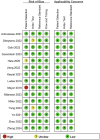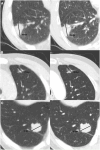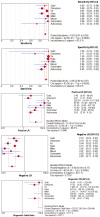Detection, measurement, and diagnosis of lung nodules by ultra-low-dose CT in lung cancer screening: a systematic review
- PMID: 39665102
- PMCID: PMC11634541
- DOI: 10.1093/bjro/tzae041
Detection, measurement, and diagnosis of lung nodules by ultra-low-dose CT in lung cancer screening: a systematic review
Abstract
Objective: There is a lack of recent meta-analyses and systematic reviews on the use of ultra-low-dose CT (ULDCT) for the detection, measurement, and diagnosis of lung nodules. This review aims to summarize the latest advances of ULDCT in these areas.
Methods: A systematic review of studies in PubMed and Web of Science was conducted, using search terms specific to ULDCT and lung nodules. The included studies were published in the last 5 years (January 2019-August 2024). Two reviewers independently selected articles, extracted data, and assessed the risk of bias and concerns using the Quality Assessment of Diagnostic Accuracy Studies-II (QUADAS-II) tool. The standard-dose, low-dose, or contrast-enhanced CT served as the reference-standard CT to evaluate ULDCT.
Results: The literature search yielded 15 high-quality articles on a total of 1889 patients, of which 10, 3, and 2 dealt with the detection, measurement, and diagnosis of lung nodules. QUADAS-II showed a generally low risk of bias. The mean radiation dose for ULDCT was 0.22 ± 0.10 mSv (7.7%) against 2.84 ± 1.80 mSv for reference-standard CT. Nodule detection rates ranged from 86.1% to 100%. The variability of diameter measurements ranged from 2.1% to 14.4% against contrast-enhanced CT and from 3.1% to 8.29% against standard CT. The diagnosis rate of malignant nodules ranged from 75% to 91%.
Conclusions: ULDCT proves effective in detecting lung nodules while substantially reducing radiation exposure. However, the use of ULDCT for the measurement and diagnosis of lung nodules remains challenging and requires further research.
Advances in knowledge: When ULDCT reduces radiation exposure to 7.7%, it detects lung nodules at a rate of 86.1%-100%, with a measurement variance of 2.1%-14.4% and a diagnostic accuracy for malignancy of 75%-91%, suggesting the potential for safe and effective lung cancer screening.
Keywords: diagnostic test; lung nodule; systematic review; ultra-low-dose CT.
© The Author(s) 2024. Published by Oxford University Press on behalf of the British Institute of Radiology.
Conflict of interest statement
The authors of this manuscript declare no relationships with any companies whose products or services may be related to the subject matter of the article.
Figures





Similar articles
-
Ultra-low-dose CT reconstructed with ASiR-V using SmartmA for pulmonary nodule detection and Lung-RADS classifications compared with low-dose CT.Clin Radiol. 2021 Feb;76(2):156.e1-156.e8. doi: 10.1016/j.crad.2020.10.014. Epub 2020 Dec 5. Clin Radiol. 2021. PMID: 33293025
-
Ultra-low dose dual-layer detector spectral CT for pulmonary nodule screening: image quality and diagnostic performance.Insights Imaging. 2025 Jan 10;16(1):11. doi: 10.1186/s13244-024-01888-1. Insights Imaging. 2025. PMID: 39792229 Free PMC article.
-
Evaluating Lung Changes in Long COVID: Ultra-Low-Dose vs. Standard-Dose CT Chest.Br J Biomed Sci. 2024 Sep 10;81:13385. doi: 10.3389/bjbs.2024.13385. eCollection 2024. Br J Biomed Sci. 2024. PMID: 39319349 Free PMC article.
-
EarlyCDT Lung blood test for risk classification of solid pulmonary nodules: systematic review and economic evaluation.Health Technol Assess. 2022 Dec;26(49):1-184. doi: 10.3310/IJFM4802. Health Technol Assess. 2022. PMID: 36534989 Free PMC article.
-
Diagnostic Performance of MRI for the Detection of Pulmonary Nodules: A Systematic Review and Meta-Analysis.Radiol Cardiothorac Imaging. 2024 Apr;6(2):e230241. doi: 10.1148/ryct.230241. Radiol Cardiothorac Imaging. 2024. PMID: 38634743 Free PMC article.
Cited by
-
Lung Cancers Associated with Cystic Airspaces.Cancers (Basel). 2025 Jan 18;17(2):307. doi: 10.3390/cancers17020307. Cancers (Basel). 2025. PMID: 39858089 Free PMC article. Review.
References
-
- Wood DE, Kazerooni EA, Aberle D, et al. NCCN Guidelines® Insights: Lung Cancer Screening, Version 1.2024. 2023. Accessed August 4, 2023. https://www.nccn.org/professionals/physician_gls/pdf/lung_screening.pdf
LinkOut - more resources
Full Text Sources

